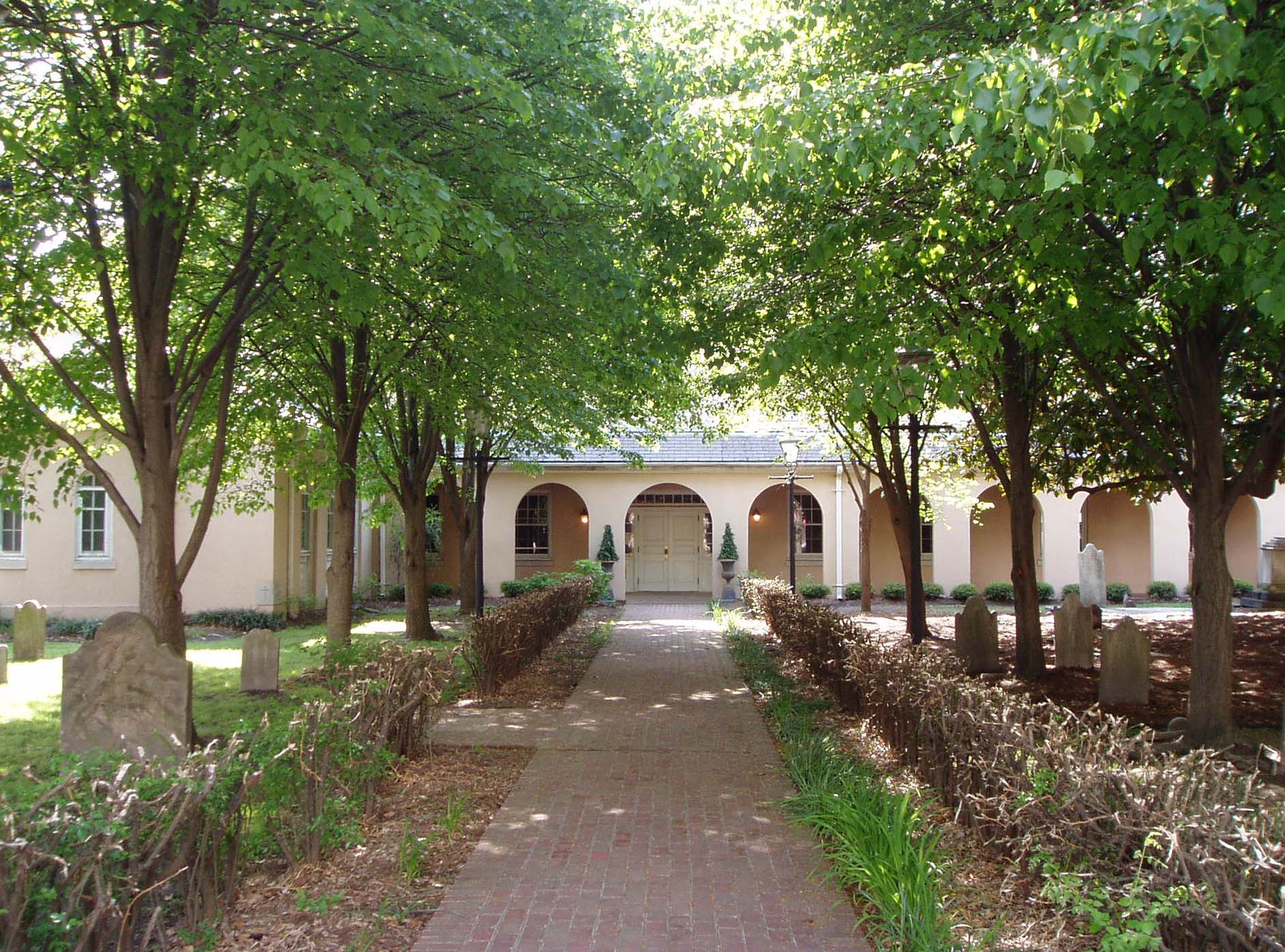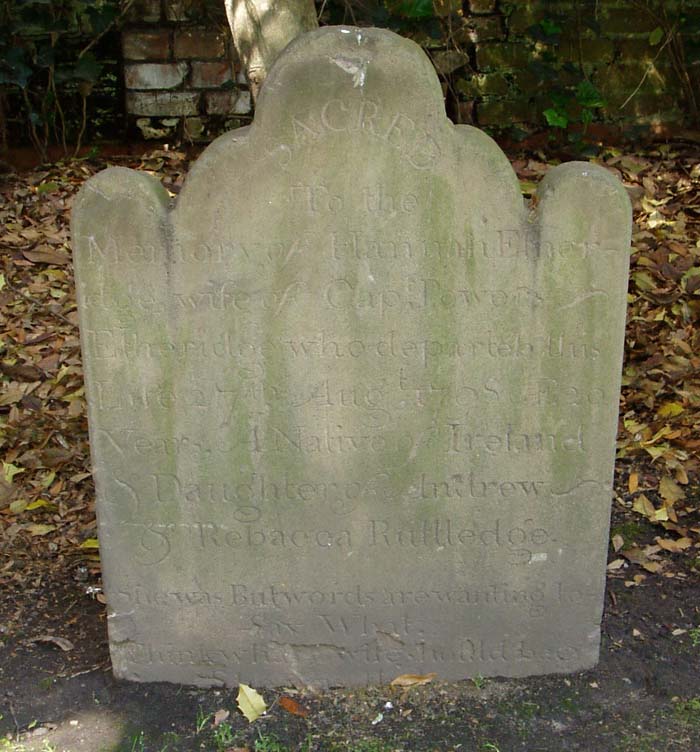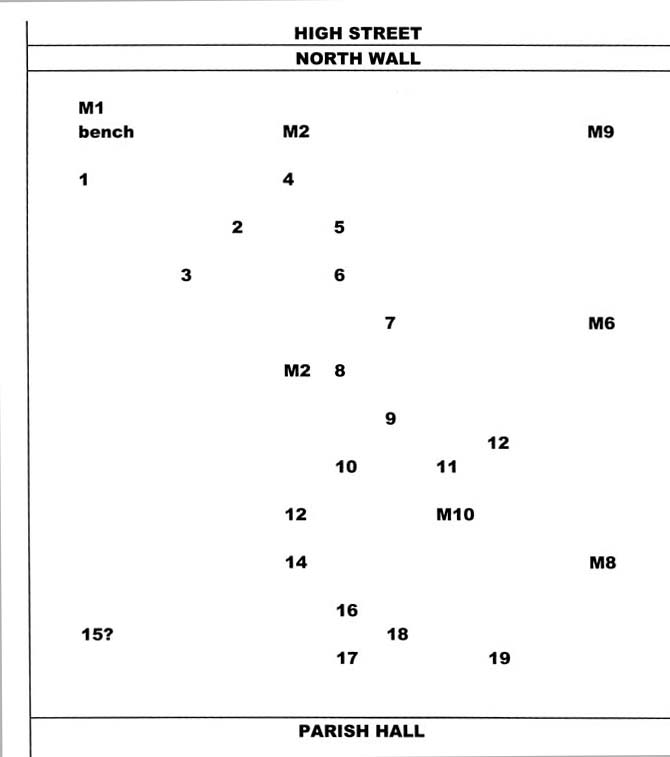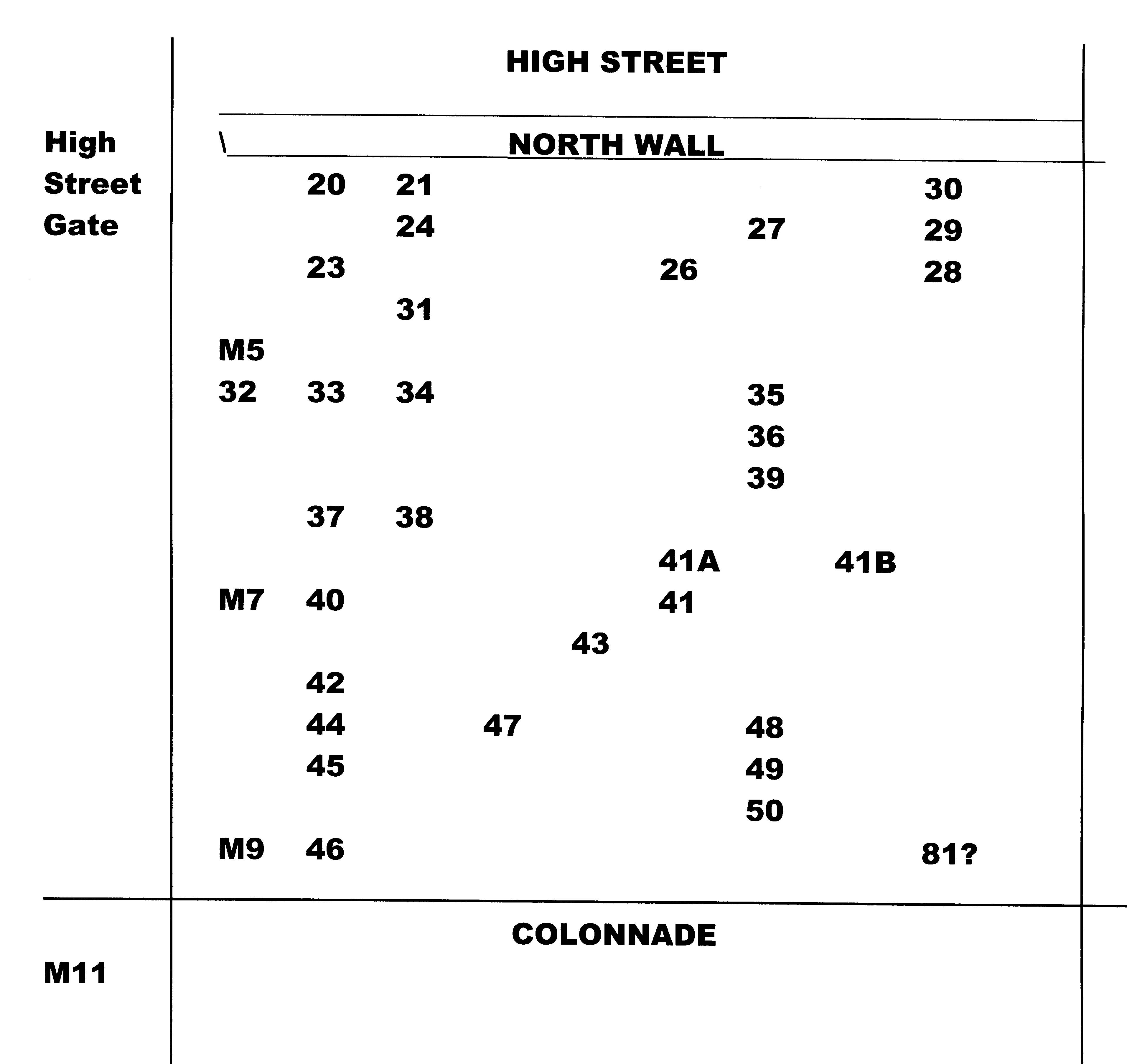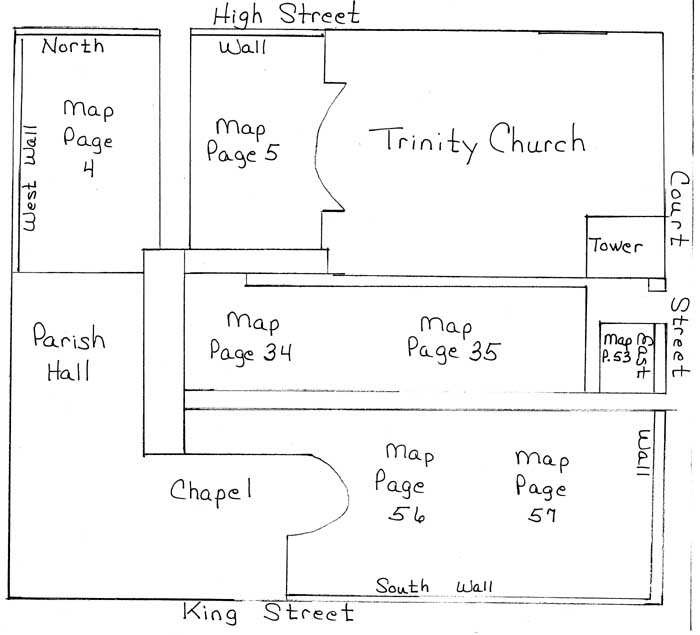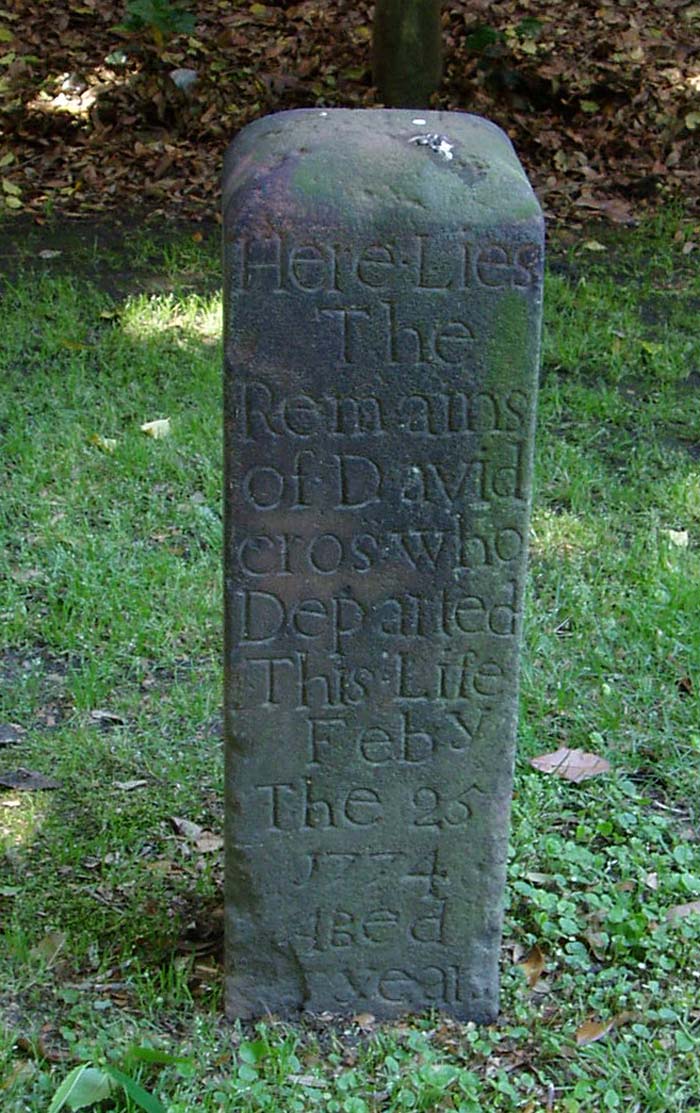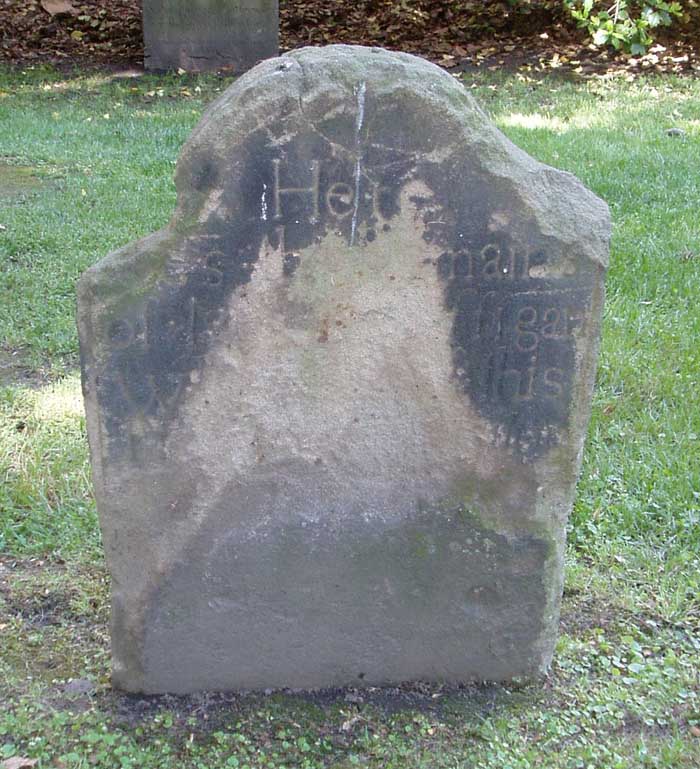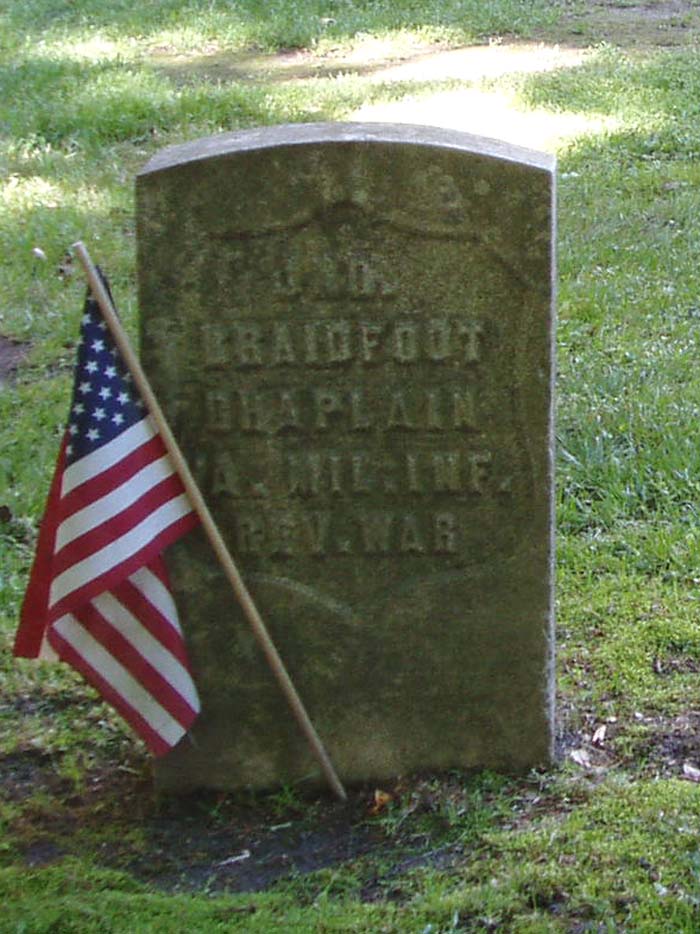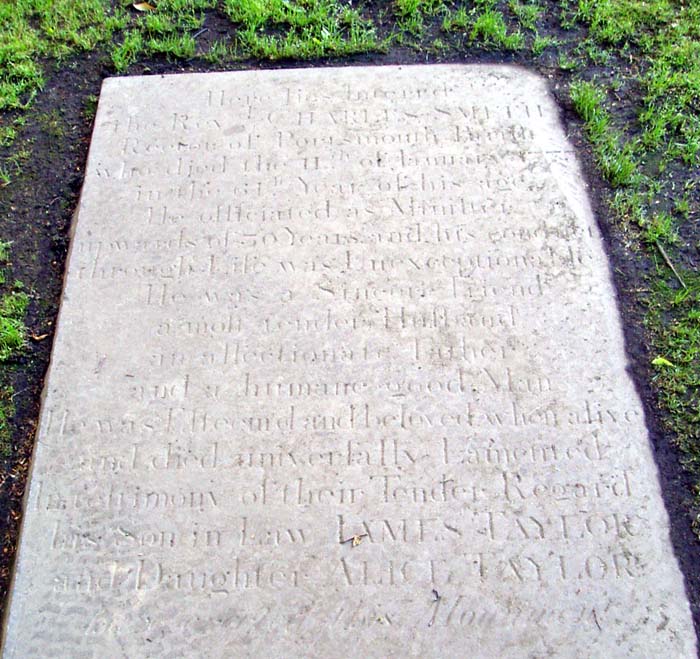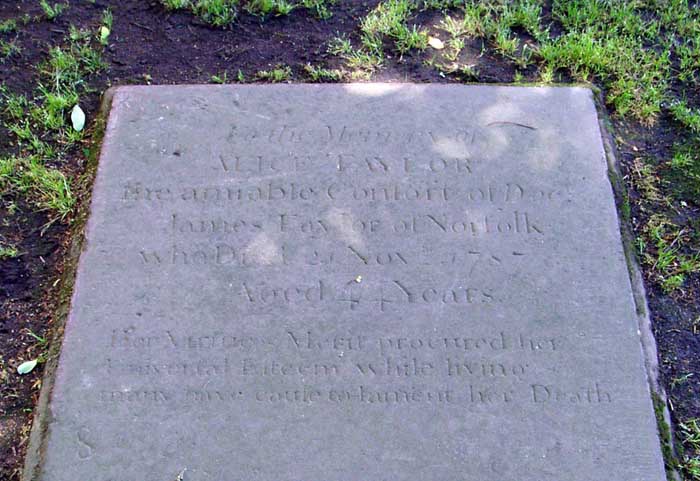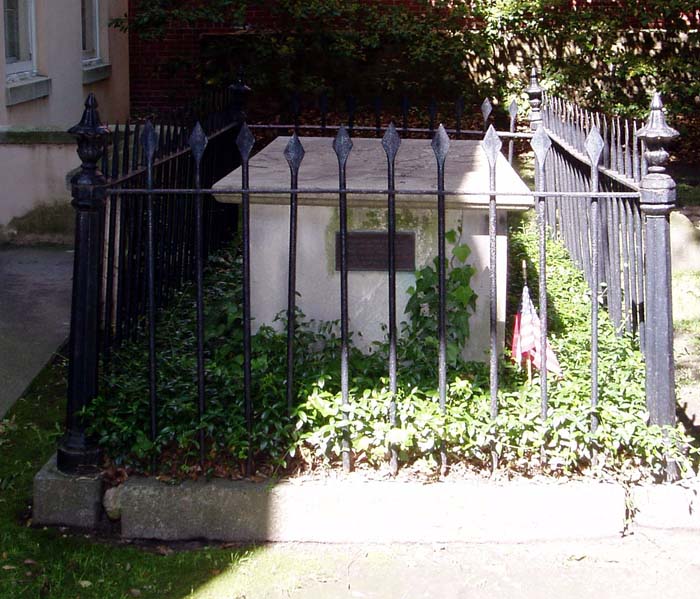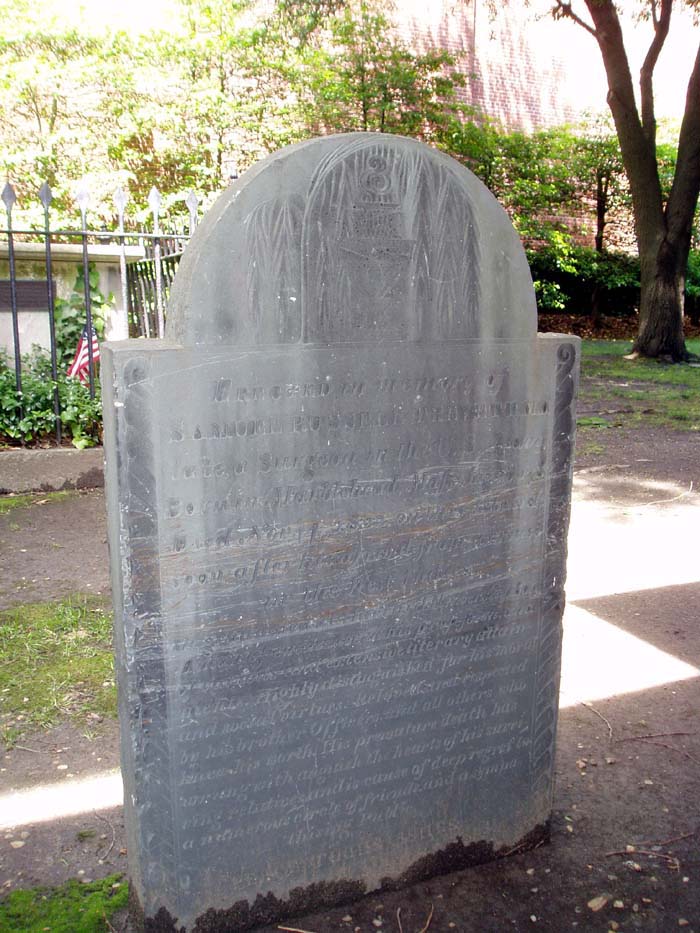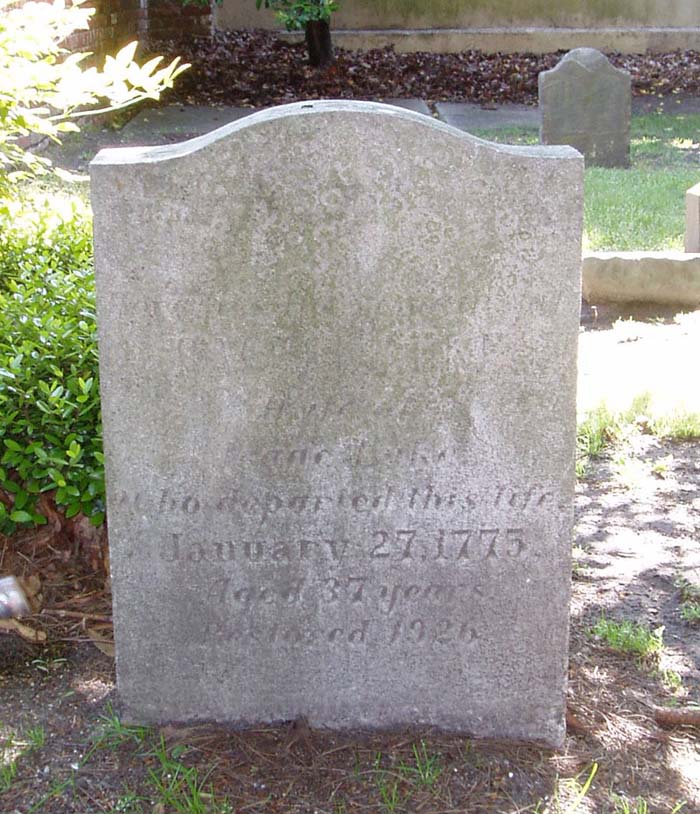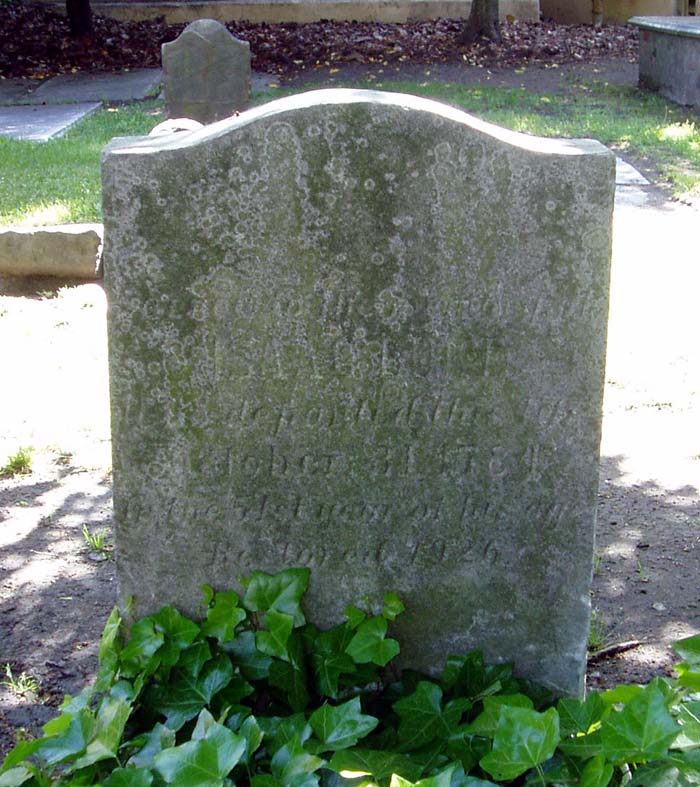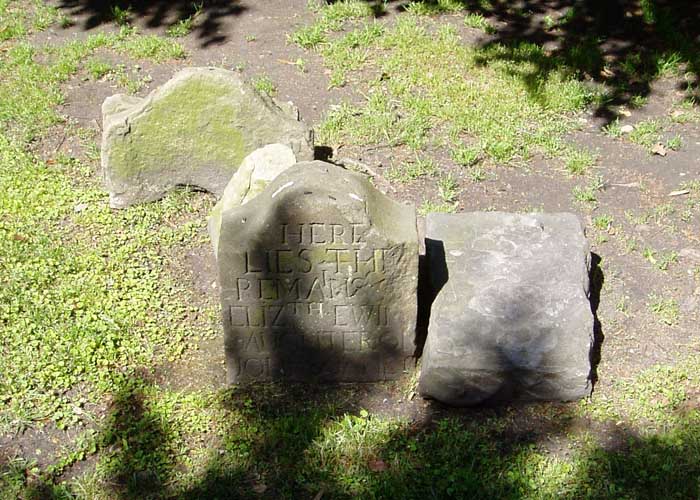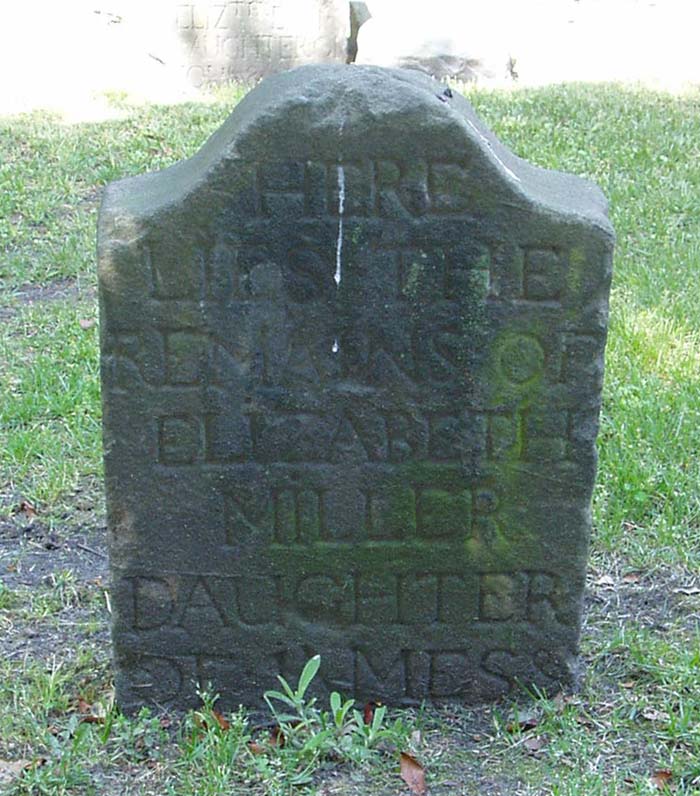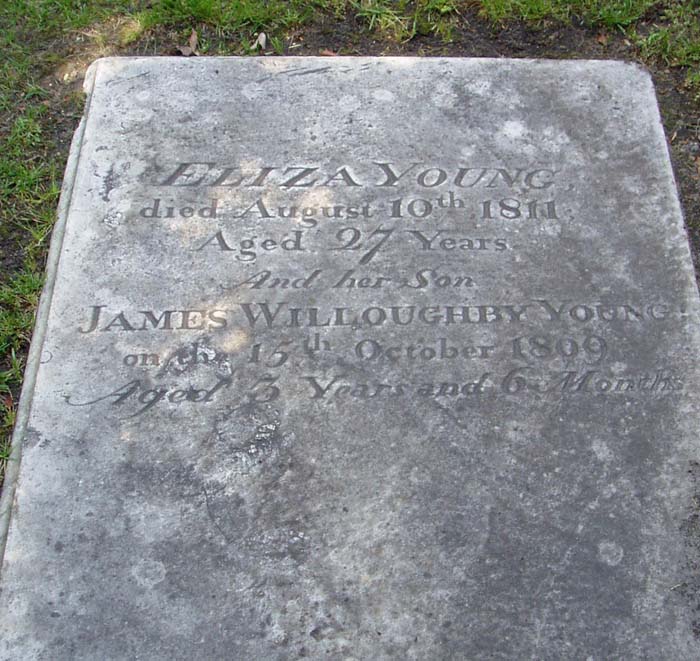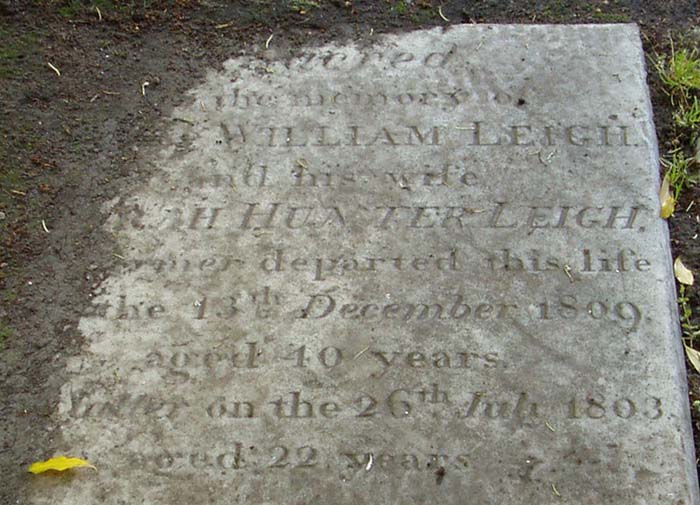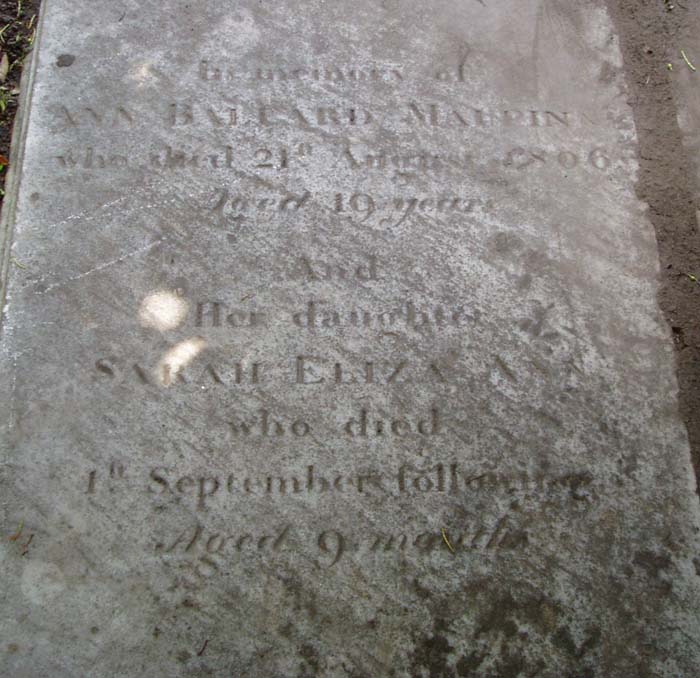USGENWEB ARCHIVES VIRGINIA
THE CITY OF PORTSMOUTH
SURVIVING GRAVESTONES AT TRINITY CHURCH
From the Inventory of Marshall Wingfield Butt
With Added Material By Dean Burgess: Trinity Church Historian
Portsmouth, Virginia 2000
Trinity Churchyard
[3] INTRODUCTIONMarshall Butt, Sr., inventoried all the graves in the space between the west end of the church and the west wall of the churchyard, now abutting the Commodore Theatre. He started at the north wall on the west side of the path and then continued on the east side of the path extending into the west end of the north section of the main churchyard. He numbered 56 grave markers in this area; although some are foot stones and so fewer actual burials are represented. He also checked inscriptions with the church records when he could find such a correlation.
He described each marker's location by the number of feet to its center from the north wall and from the west wall. Using his coordinates I have plotted their location on the map on the following pages. The locations are approximate, intended only to help a person walking in the churchyard to locate a given stone. As Butt's inventory was done about forty years ago, more of the inscriptions were legible than are today. When there is information about the deceased available in other sources I have added it. Interment was discontinued in the 1830s (except for spouses) and then resumed, in the form of cremated remains, in the 1990s.
I have attempted to amend Butt's list with as many of the markers in the main area of the churchyard as I can, using church records, a list of interesting epitaphs typewritten in the early years of the 20th century, Charles Vache's history and my own rough sketches from the originals. [Photos will be substituted when available. The reader may find a copy of the original book at Portsmouth Public Library Wilson Memorial Room.
I start with Marshall Butt Sr. 's marker number one with his drawing, orientation and material.
"Sacred to the memory of Hannah Etheridge who departed
this life 7th Aug. 1798, age 20 years - a native of Ireland
and daughter of Andrew and Rebecca Ruttledge. She
was, but words are wanting to say what. Think what a
wife should be and she was that."Her husband, Powers, was probably related to Amos Etheridge,
one of the nine men created the first Trustees (councilmen) of
the town of Portsmouth in the act creating the town on
Colonel William Crawford's land in 1752.
[4] This is the first of the maps (below) showing the location of graves. The numbers are from Marshall Butt's system. When I have added a grave he did not identify it will be followed by an "a," or "b." When the grave is no longer where he located it, I have put a question mark by it. The maps are not to scale and intended only as a rough locator. There are many modern (twentieth century) markers and they also appear on this map with the letter "M" and in a separate numbering system, starting at the northwest corner of the churchyard with "M1."
[5] The map above shows the area of the churchyard between the path to the High Street Gate in the North Wall to the Commodore Theatre and in the south to the north wall of the parish hall. The map below shows the area on the east side of the path to the High Street Gate to the west wall of the church and in the south to the covered colonnade.
The other maps can be found on the pages indicated on this plan (below) of the whole church property at the corner of Court and High Streets in the Olde Towne of Portsmouth, Virginia.
[6] STONE 2
The remains of a red stone projects about 3 feet above the ground level. It is irregular in shape and probably originally measures 7" x 7" and was similar to stone number 3 made of the same material. No inscription remains, but it is probably from the same family.
A red stone facing east: "Here lies the
remains of David Cros(s), who departed
this life February 16,1774, age __ years."
A gray stone facing east: "Here lies the remains of
Mary Goffigan who departed this life the
10th of June 1779, age 41 years."
Her foot stone is stone 5.The foot stone to stone 4, but facing west: "Here lies the
remains of Mary Goffigan. She from care whom God heth took, From Satan's sneer, In love we live. .."
More of the inscription lies bellow the turf line.
[7] Marshall Butt believed that this is Mary Veale (the Veales were original purchasers of a home site from Colonel Crawford) who married Laban Goffigan who, after her death, married Elizabeth Hansford, as reported in Norfolk County Marriage Bonds: "14 Nov., 1773, Laban Goffigan & Mary Veale; 30 Dec. 1779, Laban Goffigan & Elizabeth Hansford.
This is a modern white stone marker commemorating the
second Rector of Portsmouth Parish: The Rev. John Braidfoot.
He is believed to have been buried on the Glebe, and his
original grave site lost. "Jno. Braidfoot, chaplain, VA. MIL.
(militia) INF. (infantry), REV. (Revolutionary) War." It is also
marked by the Daughters of the American Revolution. He served
with Washington throughout the war, and returned to the parish
after the victory at Yorktown. The bell at Trinity was broken
ringing that victory.
A flat slate colored stone facing east and level with the ground.
It was moved here from the Glebe and is dedicated to the first
Rector of Portsmouth Parish: The Rev. Charles Smith. "Here
lies interr(e)d the Revd. Charles Smith, Rector of Portsmouth
Parish who died the 11th of January 1773 in the 61 st year
of his age. He officiated as minister upward of 30 years,
and his conduct through life was unexceptionable. He was a
sincere friend, an affectionate husband, and a humane good
man. He was esteem(e)d and beloved when alive and died
universally lamented. In testimony of their tender regard:
his son-in-law James Taylor and daughter Alice Taylor have
erected this monument."
[8] STONE 8
A gray stone facing east. Much of the inscription is now chipped off and unreadable.
"Here lies the remains of Elizabeth Stapp who departed this life the 24th of May 1784, age 43 years. Oh happy soul, so soon removed from trouble."
This is a flat red stone facing east.
Alice Taylor was the daughter of The Rev. Charles Smith."To the memory of Alice Taylor the amiable consort of
Dr. James Taylor of Norfolk who died 21 November
1787, age 44 years. Her virtue and merit procured her
universal esteem while living, and many have cause to
lament her death."
STONE 10
This is a red stone facing east, on which only the word "age" remains.
[9] STONE 11
This red stone is broken off almost at ground level. During the occupation by the British in the Revolution and again during the occupation of the city by Union forces the graves were not protected and from the notice reproduced below it is apparent the churchyard was neglected at times in the past. It is probably during one of these periods that stones 10 and 11 were broken off. Many graves have completely disappeared. At the end of this work I will list one person known to be buried at Trinity, but who's grave marker is now missing.
Surviving Relatives of the Dead Buried in Trinity Church Yard
A long cherished wish on the part of many people in Portsmouth has been, to put in proper order the Old Burial Ground attached to Trinity Church, which more than a century ago was enclosed as a cemetery. Here rest the remains of many whose kindred still survive, —some of them living in Portsmouth and Norfolk, others scattered far and wide. All such persons must feel it a duty and a privilege to unite with the congregation of the Church in their endeavor to clear away the wilderness of weeds and rubbish, which, for more than a hundred years have accumulated in this sacred spot. It is proposed to undertake at once, the long neglected work of restoring and beautifying the ancient Burial Ground. This pious undertaking will necessarily be attended with considerable expense.
Contributions are hereby solicited from all who sympathize with the work proposed.
Such contributions may be sent to Rev. Thos. A. Tidball, Rector of Trinity Church, or to Wm. H. Murdaugh and John C. Ashton, Wardens.
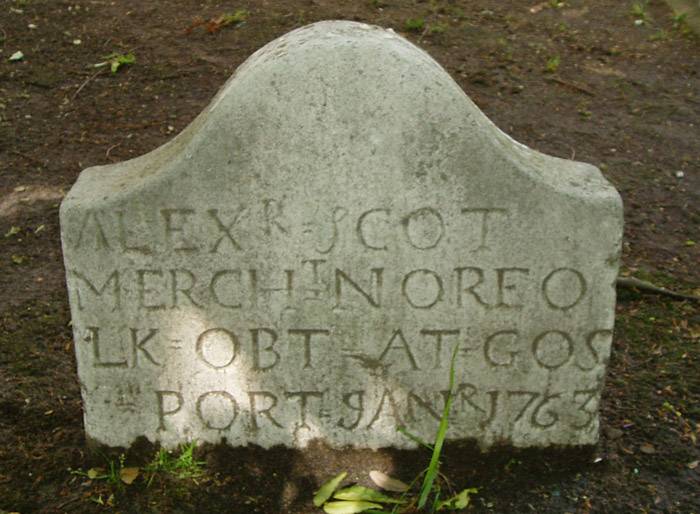
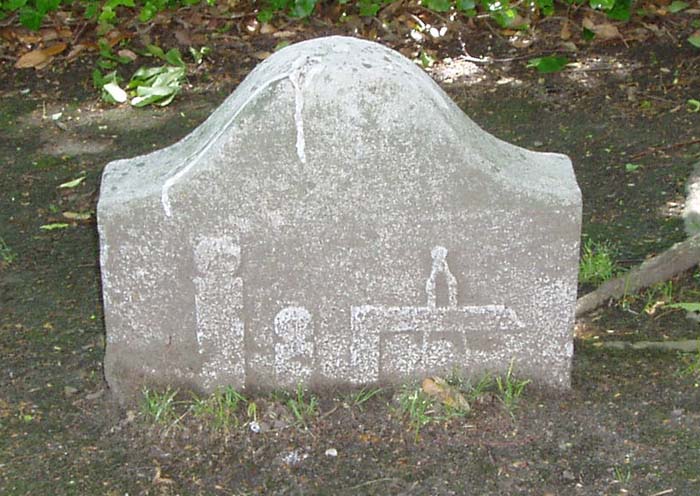
Both stones are white. The headstone above faces east and the foot stone to the left faces west. The symbols on the back of the headstone are Masonic symbols or rank. The earliest settlers of Portsmouth were Scottish merchants who wanted their homes to be in the clean and attractive new town across the river, rather than in the dirty surroundings where their business was carried out in Norfolk. Gosport was the name given to the town now outside the shipyard gates, later called Newtown, later Southside and now Port Center. The shipyard was named Gosport for the shipyard in Portsmouth, England.
This is thought to be the oldest burial in the churchyard, only eleven years after the town was laid out and one year after the completion of Portsmouth Parish, now Trinity Church. The officiator at Mr. Scott's funeral would have been the first rector, The Rev. Mr. Charles Smith.
"Alexander Scott, merchant of Norfolk. LK=OBT Gosport, January 1763. Et atis swe. 56."
Foot stone: "1763."
"The memory of Mrs. Ann Colston
who departed this life June 11, 1784,
aged 59 years seven month and eleven days.
The mother of six sons."Although I can find no mention of the Colstons at
this time, they appear [11] in the Emmerson Papers
frequently in the 1840s. These are probably her sons.
I will often mention the Emmerson Papers. They are
a collection of newspaper clippings and other loose
papers starting in the 1700s and running through
the 19th century, collected by Mr. John Cloyd
Emmerson and existing only in the Virginia
Room at the Portsmouth Public Library.
Thomas Veale was willed many of the lots Col. William Crawford laid out in the original town on Crawford's death. Jane Butler purchased one of these lots, in her own name, from Thomas on Dinwiddie Street in the block called Oxford Square in 1772. That is the block to the west of Dinwiddie Street, between Court Street and Queen Street. I will mention the "square" names several times. Portsmouth is the only American city to retain this British custom of naming the blocks. The blocks they correspond with are listed in Marshall W. Butt's Place Names of Portsmouth and I have added a rough map of them at the end of this work. Those blocks by the river abutting the street only on one side are called "rows."
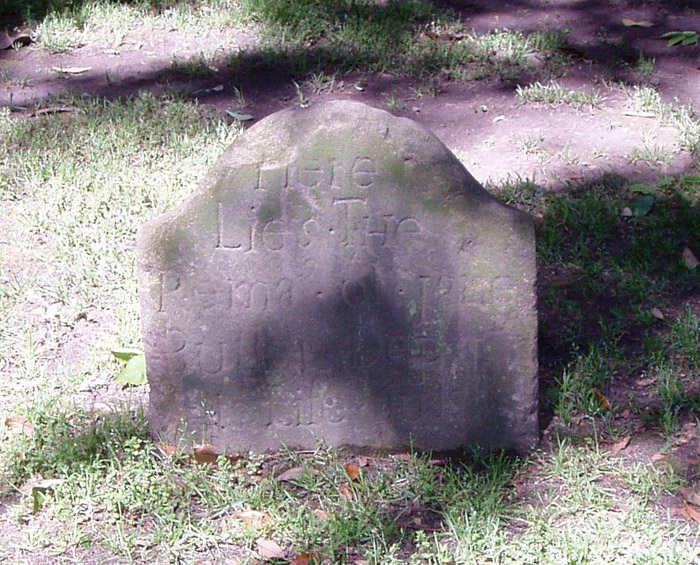
On a brown stone facing east:
"Here lies the remains of Jane Butler,
departed this life
July the 10, 1784,
age 70 years."
STONE 15
[page 12 is a drawing of the Stobo vault]
[13] On a gray stone facing east: "Sacred to the memory of Captain Jacob Stobo, late of Philadelphia, departed this life January 30, 1794, at age 34 years: affectionate husband, tender father & faithful friend. 'Tis the fate for all to die, And death no ages spare. Then each one to Jesus fly, And seek for refuge there."
These are graves of two of Commodore James Barron's grandchildren. They are both gray stones facing east. The life and times of their grandfather will come when we reach his grave.
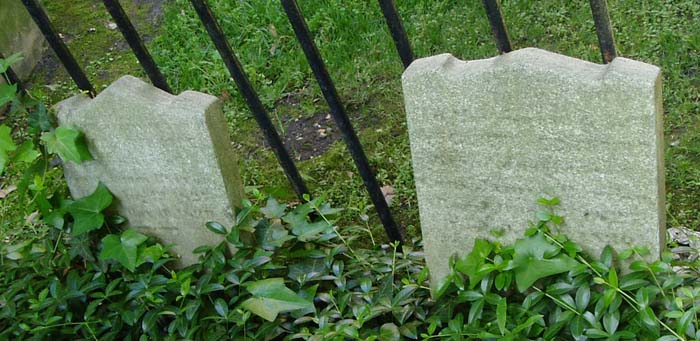
"To the memory of Margaretta E. B. Tuttle, granddaughter of Comm. James Barron,
born December 1, 1825, died October 17, 1830.""To the memory of George J. S. B. Hope, grandson of Comm. James Barron,
born August 19, 1827, died May 10, 1836."
Commodore James Barron served under his father's command in the American Revolution. After the war he joined the Navy of the new nation and commanded the ships Essex and President in the Mediterranean. In 1807 he took the newly built ship Chesapeake out into the Chesapeake Bay for a shake down cruise. The Chesapeake was the first U. S. Navy Ship to be built at the naval shipyard in Portsmouth (the old Gosport Yard). He had a crew of untried seamen on board, some had never been to sea, and very little ammunition for the new guns. They met the British warship Leopard and after a short encounter the British boarded the Chesapeake and impressed those sailors who had been born in England, they considered traitors, into the British Navy. The impressing of American sailors was one of the causes for the War of 1812. Barron, having been boarded at sea, was called before a court martial on which Stephen Decator sat. They found him innocent of cowardice, but suspended him for five years. After that he was never again given a ship. He blamed Decator and hilled him in a duel in [14] 1820. Although he never went to sea again, he had a distinguished career as Commander of the Gosport Yard, now the Norfolk Naval Shipyard in Portsmouth, credited with first suggesting iron sheeting be added to warships. At his death he was the senior officer in the U. S. Navy. His house, which does not survive, was on Elizabeth Row at the foot of Middle Street.
"James Barron, of the United States Navy, born at Hampton, Virginia, September 15, 1768, died in the City of Norfolk, April 21, 1851."
The Commodore Theater, just to the west of his grave is named for him. The theater stands on the site of the old "tax dodger" style house which was the original rectory for Portsmouth Parish and lived in by the Emmerson family. This old rectory can be seen on an early painting of Trinity, and on the plaque commemorating the Bicentennial of the Revolution in the annex of the church.
[15] STONE 19 AND 19A
This slate gray stone facing east is hard to read as it is so tight to the pillar supporting the colonnade, and its foot stone is in the wrong direction.
"Erected in memory of Samuel Russell Trevett, M. D.,
late a surgeon in the U. S. Navy -
born in Marblehead, Massachusetts,
August 20, 1783,
died November 4, 1822,
on this island [16] soon after his arrival
from a cruise in the West Indies.
He graduated at Harvard University 1804:
a man of eminence in his profession,
and of various and extensive literary attainments.
Highly distinguished for his moral and social virtues.
Beloved and esteemed by his brother officers and all . . . "
The remainder of the inscription is buried.
This is a modern white stone:
"Here lies the remains of
Rachel Luke,
wife of Isaac Luke,
who departed this life
January 27, 1775,
age 37 years.Restored 1926.
STONE 21
This is the original from which stone 21 was copied. It is now unreadable. We will hear more about the Luke's when we get to stone 24 where Isaac Luke is buried. It is a gray stone facing west.
[17] STONE 22
On a gray stone facing east: "In memory of Fanny Robinson, wife of Henry Robinson, who departed this life April 28th, 1804, in the 24th year of her age.
On a white stone similar to stone 20 facing west: "Sacred to the memory of Isaac Luke, who departed this life October 31, 1784, in the 51st year of his age. Restored 1926."
STONE 24
On a gray stone facing west: "Sacred to the memory of Isaac Luke, who departed this life October 31, 1784, in the 51st year of his age."
Isaac Luke had two houses, one destroyed by fire was on the Court Street side of Elizabeth Row where two Victorian houses now stand, and the other which still stands at 436 Court Street. In the book The Luke-Morris House his family argues that this was the house he was living in when he saved the Methodist preacher Robert Williams. Williams came in 1772. Isaac invited him to preach at the foot of Queen Street. Some Anglicans began to throw stones at him in that public place. Methodism protested against the Church of England. [18] Isaac saved the man and allowed him to preach from his front porch. Since Isaac had been a vestryman at Portsmouth Parish, no stones would be thrown there. This was the first time Methodism was preached in the South, and is the incident on which Monumental Methodist bases its claim to be the oldest Methodist congregation in the South.
Two other stories are told about Isaac and his family. During the British occupation of the city in the American Revolution, some drunken British soldiers, knowing his fondness for the cause of the patriots, broke some bottles and made him walk barefoot on the pieces. His daughter is also said to have thrown a ring, given her by her sweetheart in the American army, out the back door to keep it from being taken by the British. The ring was never found. Isaac Luke is listed as a joiner and probably used this skill in shipbuilding and house construction.
On a gray stone facing east:
"Here lies the remains of Elizabeth Ewing,
daughter of John and Janet Ewing, 1773."John Ewing was the town banker
and lived on Court House Square
on Middle Street. There is a record
of him selling property to William Thompson,
a mariner, in 1771 (of whom more later).
[19] STONE 26
On a gray stone facing east: "Here lies the remains of
Elizabeth Miller, daughter of James and Elizabeth Miller - 1773."James Miller is listed as "a merchant of Portsmouth." He sold
a lot on Back Creek Square in 1768 to George Bowness; the town
tanner. James purchased a lot in 1770 on Dinwiddie at King
Streets and then another in 1771 at Court and London Streets.
One of these may have been his residence and the other his
place of business.
On a flat white stone facing east: "Eliza Young, died August 10, 1811; aged 27 years and her son, James Willoughby Young, on the 15th October, 1809; age 3 years and six months.
A rector of Trinity was named Young, but I cannot identify which Young family she represents from this stone.
Her son's middle name may have come from the family for which Willoughby Spit is named. They did own land near the Naval Hospital at one time.
On a flat white stone facing east: "Sacred to the memory of Dr. William Leigh, and his wife Sarah Hunter Leigh, the former departed this life on the 13th December 1809, age 40 years, the latter on the 26th July 1803, aged 22 years."
Dr. Leigh appears in the List of Tithables in the Emmerson Papers in 1798.
In 1805 he offered for rent a storehouse near the market on Market Square directly across from Trinity Church (the old market building survives as the second story of a house on Red Lion Square on the south side of Glasgow Street between Crawford and Middle), and " . . . a beautiful seat near Portsmouth called The Cottage, near the ferry wharf (which would then have been at North Harbor where Harbor Towers now stands and the ferry still picks up passengers) with a view of Norfolk harbour."
He sold a distillery at Gosport with 4 stills, ". . . from which 300 gallons of spirits may be produced . . ." in the year he died.
On a flat white stone facing east: "In memory of Ann Ballard Maupin who died 21st August 1806, age 19 years, and her daughter Sarah Eliza Ann, who died first September following, aged 9 months."
In her obituary she is identified as the wife of Dr. George Washington Maupin and the daughter of James Young, Esq. It says she died at Gosport "In the early bud of youth."
The Maupins became a prominent family in the town. They still own the house on the Court Street side of Hampton Row which replaced the original. They are members of Trinity almost 200 years after Ann's death.
